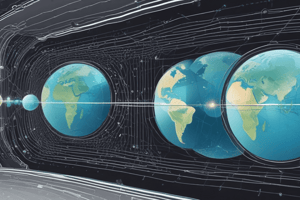Podcast
Questions and Answers
Which purpose does visualization NOT primarily serve?
Which purpose does visualization NOT primarily serve?
- Making decisions
- Telling a story
- Finding patterns
- Encoding data for storage (correct)
What is one of the key values of information visualization?
What is one of the key values of information visualization?
- Increasing processing speed
- Recording information (correct)
- Enhancing data storage
- Hiding data complexity
How does visualization support reasoning?
How does visualization support reasoning?
- By simplifying data entry
- By replacing analytical methods
- By finding patterns and discovering errors (correct)
- By enabling collaboration
Which of the following is NOT a reason for creating visualizations?
Which of the following is NOT a reason for creating visualizations?
Which method can visualization not directly help with?
Which method can visualization not directly help with?
What is a primary goal of using visualization in decision making?
What is a primary goal of using visualization in decision making?
In what way does visualization help expand memory?
In what way does visualization help expand memory?
Which of the following does not relate to analyzing data for reasoning in visualization?
Which of the following does not relate to analyzing data for reasoning in visualization?
What is one key application of information visualization related to communications?
What is one key application of information visualization related to communications?
According to John Tukey, what is considered the greatest value of a picture?
According to John Tukey, what is considered the greatest value of a picture?
What role does reasoning play in the visualization process?
What role does reasoning play in the visualization process?
Which statement best reflects the essence of exploration in data visualization?
Which statement best reflects the essence of exploration in data visualization?
What can be concluded about the surprises in the data based on W. Cleveland's observation?
What can be concluded about the surprises in the data based on W. Cleveland's observation?
What might indicate that visualization is not the best approach according to J. Stasko?
What might indicate that visualization is not the best approach according to J. Stasko?
What main purpose does the visualization process serve?
What main purpose does the visualization process serve?
What type of outcome might one expect when visualizing data, as suggested in the content?
What type of outcome might one expect when visualizing data, as suggested in the content?
What was the purpose of E.J. Marey's sphygmograph?
What was the purpose of E.J. Marey's sphygmograph?
Which graphical representation is noted for its ability to persuade?
Which graphical representation is noted for its ability to persuade?
What aspect did London’s underground map revisions from 1926 to 1987 primarily focus on?
What aspect did London’s underground map revisions from 1926 to 1987 primarily focus on?
What is one of the roles of infographics stated in the content?
What is one of the roles of infographics stated in the content?
In what context was the exercise involving multiplying 34 by 72 presented?
In what context was the exercise involving multiplying 34 by 72 presented?
What significant observation was made from the London Cholera Map?
What significant observation was made from the London Cholera Map?
Which example illustrates finding patterns in data?
Which example illustrates finding patterns in data?
What communication action does the term 'persuade' notably refer to in the context provided?
What communication action does the term 'persuade' notably refer to in the context provided?
What is the primary goal of the data transformation stage?
What is the primary goal of the data transformation stage?
Which stage involves obtaining data from various sources?
Which stage involves obtaining data from various sources?
In which stage is the acquired data structured into categories?
In which stage is the acquired data structured into categories?
What occurs during the Filter stage of visualization?
What occurs during the Filter stage of visualization?
Which of the following best describes the Mine stage?
Which of the following best describes the Mine stage?
What is the purpose of the Refine stage in the visualization process?
What is the purpose of the Refine stage in the visualization process?
What does the Interact stage focus on in data visualization?
What does the Interact stage focus on in data visualization?
Choosing a visual model, such as a bar graph or tree, falls under which stage?
Choosing a visual model, such as a bar graph or tree, falls under which stage?
What is R primarily known for?
What is R primarily known for?
Which command is used to install a package in R?
Which command is used to install a package in R?
Which of the following is a recommended way to seek help with an R function?
Which of the following is a recommended way to seek help with an R function?
What does the 'demo(is.things)' command do in R?
What does the 'demo(is.things)' command do in R?
What is CRAN in relation to R?
What is CRAN in relation to R?
Which of the following options does NOT represent a possible action in data interaction?
Which of the following options does NOT represent a possible action in data interaction?
In the context of R, what does the term 'functional programming' imply?
In the context of R, what does the term 'functional programming' imply?
Which organization primarily initiated the development of R?
Which organization primarily initiated the development of R?
Flashcards are hidden until you start studying
Study Notes
Why Create Visualizations?
- Visualizations can help us answer questions, discover new ones, make decisions, and see data in context.
- They can expand our memory, support graphical calculations, find patterns, present arguments or tell stories, and inspire.
Summary of Reasons
- Record information: Capture information like blueprints, photographs, or seismographs for documentation.
- Communicate: Share and persuade others with visuals, facilitating collaboration and revision.
- Analyze data: Find patterns, detect errors in data, expand memory, and develop and test hypotheses.
Key Applications of IV
- Record information: Documenting data.
- Communication (Presentation) : Communicating data and ideas, explaining, informing, providing evidence, and influencing.
- Reasoning (Analysis): Exploring data, assessing situations, determining action, and making decisions.
The Visualization Process
- Data transformation: Creating a structural model to organize raw data into data tables.
- Visual mapping: Transforming data tables into visual structures.
- View Transformations: Creating visual representations by adjusting graphical parameters like position, scaling, and clipping.
Seven Stages of Visualization
- Acquire: Obtain source material from files or networks.
- Parse: Structure the data and categorize it.
- Filter: Remove irrelevant data.
- Mine: Detect patterns or analyze data in a mathematical context.
- Represent: Choose a visual model like histograms, charts, or trees.
- Refine: Enhance the visual representation for clarity and engagement.
- Interact: Allow manipulation of the data and control over visible features.
Interaction is Vital for Exploration
- Engage in a dialog with your data to gain a deeper understanding.
- Interaction strengthens the power of visualizations.
- Possible interaction actions include: selecting, exploring, reconfiguring, filtering, connecting, and encoding.
R Introduction
- R: A free software environment for statistical computing and graphics.
- GNU project: Created by John Chambers at Bell Labs.
- Programming language: Primarily written in C and Fortran.
- IDE: Use R Studio for a more intuitive interface.
- CRAN: Install packages from the command line:
install.packages("ggplot2", dependencies = TRUE) - Get R help: Use the built-in
help(func)or?funcfunctions. For a topic usehelp.search(topic),??topicordemo(is.things). Find resources online atsearch.r-project.organd on Stack Overflow.
Studying That Suits You
Use AI to generate personalized quizzes and flashcards to suit your learning preferences.




